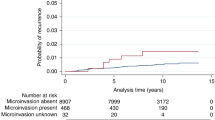Abstract
The influence of extensive intraductal component (EIC) on local recurrence risk was studied for 496 patients with stage I-II infiltrating ductal cancers treated by conservative surgery and irradiation. EIC was diagnosed in 65 of 231 (28%) premenopausal and 41 of 265 (15.5%) post-menopausal patients. Local recurrence risk was markedly increased in EIC+ patients (5-year actuarial risk 18% versus 8% without EIC, P less than 0.001), but this effect appeared limited to premenopausal patients. Local recurrence risk increased with increasing degree of EIC. EIC with more than 50% intraductal carcinoma was more prevalent in patients younger than 40, perhaps accounting to some degree for the higher local recurrence rates observed in younger patients. The presence of EIC had no influence on overall survival, on median time to local recurrence, or on short-term survival after local failure. The usefulness of EIC as a risk factor for local recurrence is discussed.
This is a preview of subscription content, access via your institution
Access options
Subscribe to this journal
Receive 24 print issues and online access
$259.00 per year
only $10.79 per issue
Buy this article
- Purchase on Springer Link
- Instant access to full article PDF
Prices may be subject to local taxes which are calculated during checkout
Similar content being viewed by others
Author information
Authors and Affiliations
Rights and permissions
About this article
Cite this article
Jacquemier, J., Kurtz, JM., Amalric, R. et al. An assessment of extensive intraductal component as a risk factor for local recurrence after breast-conserving therapy. Br J Cancer 61, 873–876 (1990). https://doi.org/10.1038/bjc.1990.195
Issue Date:
DOI: https://doi.org/10.1038/bjc.1990.195
This article is cited by
-
Postmastectomy locoregional recurrence and recurrence-free survival in breast cancer patients
World Journal of Surgical Oncology (2010)
-
Standardized and reproducible methodology for the comprehensive and systematic assessment of surgical resection margins during breast-conserving surgery for invasive breast cancer
BMC Cancer (2009)
-
Factors predicting in-breast tumor recurrence after breast-conserving surgery
Breast Cancer Research and Treatment (2009)
-
Gene expression profiling in primary breast cancer distinguishes patients developing local recurrence after breast-conservation surgery, with or without postoperative radiotherapy
Breast Cancer Research (2008)
-
Ipsilateral Breast Tumor Recurrence after Breast‐conserving Therapy: A Comparison of Quadrantectomy versus Lumpectomy at a Single Institution
World Journal of Surgery (2005)



